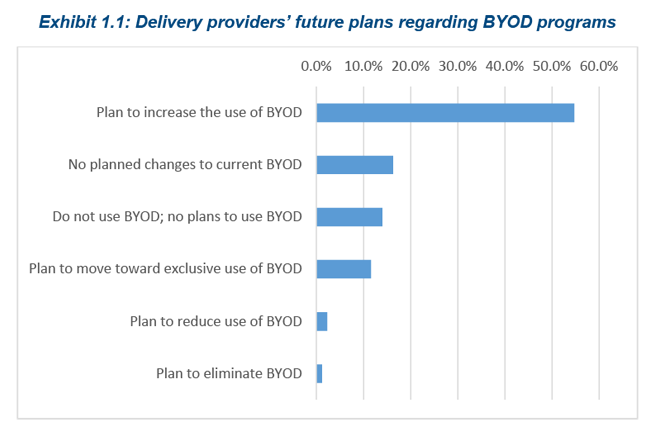Enterprise Mobility & the Connected Worker Blog
Competition for scarce labor drives BYOD resurgence in delivery organizations
Current labor shortages are forcing organizations to compete for labor like never before. According to the Bureau of Labor Statistics, the United States labor participation rate was 61.8% in November. While this is the highest rate seen since March 2020, it is still far below levels observed leading up to March 2020 which hovered consistently around 63%. This labor shortage is not unique to the United States, nor is it expected to abate anytime soon. These constraints are affecting transportation and logistics organizations in particular, especially given that while workers were leaving the labor force in droves, delivery fleets were forced to expand to accommodate the tremendous increase in e-Commerce volume demand.
The impetus for delivery providers to compete for labor in new ways has led many to target improvements to the worker experience, namely by creating or expanding existing bring-your-own-device (BYOD) programs. According to a recent VDC Research survey of transportation and logistics decision-makers, nearly two-thirds of delivery providers are expanding their BYOD programs; 11.6% of respondents even said their drivers will operate exclusively under a BYOD model (Exhibit 1.1). Two of the most frequently indicated factors driving BYOD adoption are “employee preference” and “increased employee productivity.” These are expected, as they are common arguments for the adoption of BYOD. Employees will naturally prefer to have more choice regarding which device they use for forty or more hours each week. Productivity is expected to improve as workers can opt for the device with which they are most comfortable, usually one in the same ecosystem as their personal devices. The interestingly, if not surprisingly, common response was that BYOD is “attractive to potential hires,” which was cited by over 50% of survey respondents. It is interesting to see organizations leverage BYOD as a means to attract new hires. Notably, it may be the only approach to compete for labor which does not inherently increase labor or recruiting costs and can actually reduce the organization’s overall costs.
Not all organizations are enthusiastic about BYOD policies. About 14% of respondents indicated their organization does not have a current BYOD program nor plans to launch one. A small but noteworthy 3.5% indicated their organization had plans to reduce or eliminate their existing BYOD program for delivery drivers. Top reasons indicated by those who will not be ramping up their BYOD programs include: security concerns, the need to monitor devices, and quality concerns regarding low-end devices. While these concerns are legitimate, they can be quashed by establishing robust policies surrounding BYOD and selecting the right partners, such as a Mobile Device Management (MDM) provider to ensure device security and visibility do not suffer as a result of BYOD adoption. Concerns about low-end devices can be eliminated altogether by setting clear standards for device specifications or limiting allowable devices to only those which can be trusted to handle the expected workload.
The labor crunch could not have come at a worse time for delivery organizations, and the increase in BYOD programs is an interesting trend to watch among the incentives which organizations utilize to compete for limited workers. However, the current labor shortage is just one of many challenges which transportation and logistics organizations will face now or in the next several years. Several key challenges are actually ranked as more impactful by logistics decision-makers. These issues will be laid out and analyzed in detail in VDC’s upcoming report Addressing Last Mile Delivery Service Challenges with Modern Mobile Solutions.
